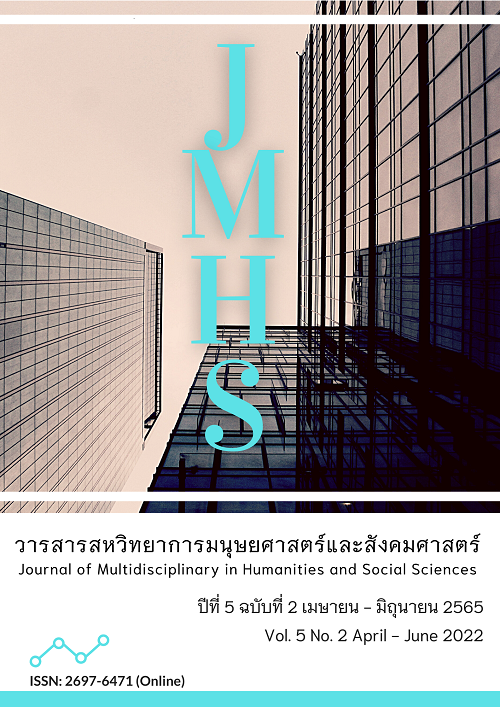วิเคราะห์ความสำคัญของเวทนาต่อการเจริญวิปัสสนาภาวนาในเวทนาสูตร
Main Article Content
บทคัดย่อ
บทความนี้มีวัตถุประสงค์ 2 ประการ คือ 1) ศึกษาเนื้อหาและหลักธรรมสำคัญในเวทนาสูตร และ 2) วิเคราะห์ความสำคัญของเวทนาต่อการเจริญวิปัสสนาภาวนาในเวทนาสูตร โดยการศึกษาค้นคว้าข้อมูลจากคัมภีร์พระไตรปิฎก อรรถกถา ฎีกา อนุฎีกา คัมภีร์วิสุทธิมรรค และจากหนังสือเอกสาร งานวิจัยต่าง ๆ ที่เกี่ยวข้อง แล้วนำมาเรียบเรียงบรรยายตรวจสอบโดยผู้เชี่ยวชาญ ผลการวิจัยพบว่า เนื้อหาและหลักธรรมสำคัญในเวทนาสูตร เวทนา 3 หมายถึง ความรู้สึกในการเสวยอารมณ์ 3 ทาง ได้แก่ 1) สุขเวทนา คือ ความรู้สึกสุข 2) ทุกขเวทนา คือ ความรู้สึกทุกข์ และ 3) อทุกขมสุขเวทนา คือ (ความรู้สึกที่มิใช่สุขมิใช่ทุกข์) และอริยมรรคมีองค์ 8 คือ ข้อปฏิบัติอันเป็นทางสายกลาง 8 ประการ การวิเคราะห์ความสำคัญของเวทนาต่อการเจริญวิปัสสนาภาวนาในเวทนาสูตร พบว่าเวทนา 3 ที่มีความสำคัญต่อการเจริญวิปัสสนาภาวนา คือการกำหนดรู้เท่าทันต่อ สุขเวทนา ทุกขเวทนา และอทุกขมสุขเวทนา ที่เกิดขึ้นทางกายและใจ สักว่าเป็นแต่เพียงเวทนาที่เกิดขึ้นตามเหตุปัจจัยเท่านั้น เวทนานี้เมื่อเกิดขึ้นก็เพราะด้วยเหตุปัจจัยให้เกิดขึ้น เมื่อตั้งอยู่ก็ด้วยเหตุปัจจัยให้ตั้งอยู่ เมื่อดับก็ด้วยเหตุปัจจัยให้ดับไปในที่สุด ผู้เจริญวิปัสสนาภาวนาตามหลักธรรมในอริยมรรคมีองค์ 8 ได้ชื่อว่า ดำเนินตามทางสายกลาง ย่อมประสบผลสำเร็จ คือ ยังมรรค ผล นิพพาน ให้เกิดขึ้นได้ ทำให้พ้นจากกองทุกข์ทั้งปวงในสังสารวัฏ และเข้าถึงพระนิพพานซึ่งเป็นแดนเกษมอันเป็นสุขที่แท้จริง
Article Details

อนุญาตภายใต้เงื่อนไข Creative Commons Attribution-NonCommercial-NoDerivatives 4.0 International License.
ทัศนะและความคิดเห็นที่ปรากฏในวารสาร ถือเป็นความรับผิดชอบของผู้เขียนบทความนั้น และไม่ถือเป็นทัศนะและความรับผิดชอบของกองบรรณาธิการ
เอกสารอ้างอิง
พระพรหมคุณาภรณ์ (ป. อ. ปยุตฺโต). (2554). พจนานุกรมพุทธศาสน์ ฉบับประมวลศัพท์. (พิมพ์ครั้งที่ 16). กรุงเทพฯ: สหธรรมิก.
พระพรหมคุณาภรณ์ (ป.อ.ปยุตฺโต). (2546). พุทธธรรม. (พิมพ์ครั้งที่ 11). กรุงเทพฯ: มหาจุฬาลงกรณราชวิทยาลัย.
พระพัฒสา ปวฑฺฒโน. (2561). ศึกษาประโยชน์และคุณค่าของเวทนาในการปฏิบัติวิปัสสนากรรมฐานตามแนวสติปัฏฐาน 4(วิทยานิพนธ์พุทธศาสตรมหาบัณฑิต). มหาวิทยาลัยมหาจุฬาลงกรณราชวิทยาลัย.
พระพุทธโฆสเถระ. (2548). คัมภีร์วิสุทธิมรรค. (สมเด็จพระพุฒาจารย์ (อาจ อาสภมหาเถระ), แปล). (พิมพ์ครั้งที่ 6). กรุงเทพฯ: ธนาเพรส.
พระมหานพดล นวตลปญฺโญ, พระครูสุธีคัมภีรญาณ (ประมวล) และ พระมหามิตร ฐิตปญฺโญ. (2564). รูปแบบการปฏิบัติธุดงควัตรของพระสงฆ์ในลุ่มแม่น้ำโขง
(ไทย-ลาว). วารสารศิลปการจัดการ, 5(2), 325-339.
พระมหาสุบิน สุนฺทรธมฺโม และพระมหาบุญศรี ญาณวุฑฺโฒ. (2564). ศึกษาการปฏิบัติวิปัสสนาภาวนาในอัจฉราสูตร. วารสาร มจร บาฬีศึกษาพุทธโฆสปริทรรศน์, 7(1), 123-134.
พระสมชาย บัวแก้ว, พระมหาบุญศรี วงค์แก้ว และ สุเชาวน์ พลอยชุม. (2564). อภิสมาจาร: กระบวนการพัฒนาบุคลิกภาพตามแนวพระพุทธศาสนา. วารสารศิลปการจัดการ, 5(3), 895-907.
พระอนุชา อนุซาโต. (2556). การศึกษาการเจริญเวทนานุปัสสนาในคัมภีร์พระพุทธศาสนาเถรวาท (วิทยานิพนธ์พุทธศาสตรมหาบัณฑิต). มหาวิทยาลัยมหาจุฬาลงกรณราชวิทยาลัย.
พุทธทาส ภิกขุ. (2534). หลักพุทธธรรม. (พิมพ์ครั้งที่ 2). กรุงเทพฯ: สุขภาพใจ.
มหาจุฬาลงกรณราชวิทยาลัย. (2539). พระไตรปิฎกภาษาไทย ฉบับมหาจุฬาลงกรณราชวิทยาลัย. กรุงเทพฯ: โรงพิมพ์มหาจุฬาลงกรณราชวิทยาลัย.
มหาจุฬาลงกรณราชวิทยาลัย. (2552). อรรถกถาภาษาไทย ฉบับมหาจุฬาลงกรณราชวิทยาลัย. กรุงเทพฯ: โรงพิมพ์มหาจุฬาลงกรณราชวิทยาลัย.
สังข์วาล เสริมแก้ว, ธานี สุวรรณประทีป, ชลิต วงษ์สกุล และ พระครูปลัดประวิทย์ วรธมฺโม. (2565). การบูรณาการหลักอัตถะ 3 ในการสังคมสงเคราะห์ : บทวิเคราะห์ในมิติพระพุทธศาสนา. วารสาร มจร บาฬีศึกษาพุทธโฆสปริทรรศน์, 8(1),1-15.
อุไรพร ประชาบุตร และ วิไลศักดิ์ กิ่งคำ. (2564). ศึกษาความสัมพันธ์ระหว่างอานาปานสติกับไตรลักษณ์ ในคัมภีร์พระพุทธศาสนาเถรวาท. วารสาร มจร บาฬีศึกษาพุทธโฆสปริทรรศน์, 7(2), 1-12.
Damnoen, P. S. (2021). The Development of Student Characteristics in According to the Nawaluk Framework of the Buddhist integration of Buddhapanya Sri Thawarawadee Buddhist College. Asia Pacific Journal of Religions and Cultures, 5(2), 126-135.
Tan, C. C., & Damnoen, P. S. (2020). Buddhist Noble Eightfold Path Approach in the Study of Consumer and Organizational Behaviors. Journal of MCU Peace Studies, 8(1), 1–20.


